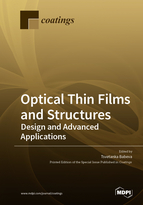Optical Thin Films and Structures: Design and Advanced Applications
A special issue of Coatings (ISSN 2079-6412).
Deadline for manuscript submissions: closed (20 April 2020) | Viewed by 36661
Special Issue Editor
Interests: thin films optics; multilayered structures; sensors with optical read-out; porous thin films and structures; zeolite nanocomposites
Special Issues, Collections and Topics in MDPI journals
Special Issue Information
Dear Colleagues,
You are cordially invited to submit your original work to this Special Issue devoted to “Optical Thin Films and Structures: Design and Advanced Applications”. Diverse types of materials such as polymers, glasses, metals, ceramics, zeolites, etc., could be prepared as thin films with high optical quality, thus finding applications in photonics, optical sensing, photocatalysis, optoelectronics, linear and non-linear optics, holography, etc. Different production strategies, including ‘dry’ and ‘wet’ deposition methods, are developed and optimized. In order for these thin films and structures to be utilized in different optical devices, unambiguous methods for their design and characterization are required. Additionally, in-situ optical monitoring of their properties will be beneficial for proper device operation.
This Special Issue will cover the recent progress and new developments in the area of the design, deposition, characterization, and application of optical thin films and structures.
In particular, the topics of interest include, but are not limited to the following:
- Design of complex thin films and structures;
- Deposition strategies for optical thin films and multilayered structures;
- Antireflective thin film coatings;
- Thin films and structures for optical sensing of humidity, VOC’s, gases, heavy metal ions, etc.;
- Optical thin films in photocatalysis;
- Optical thin films in solar cells;
- Optical thin films in light emitting devices;
- Transparent and conductive thin films and structures;
- Optical thin films and structures for security devices.
Prof. Dr. Tsvetanka Babeva
Guest Editor
Manuscript Submission Information
Manuscripts should be submitted online at www.mdpi.com by registering and logging in to this website. Once you are registered, click here to go to the submission form. Manuscripts can be submitted until the deadline. All submissions that pass pre-check are peer-reviewed. Accepted papers will be published continuously in the journal (as soon as accepted) and will be listed together on the special issue website. Research articles, review articles as well as short communications are invited. For planned papers, a title and short abstract (about 100 words) can be sent to the Editorial Office for announcement on this website.
Submitted manuscripts should not have been published previously, nor be under consideration for publication elsewhere (except conference proceedings papers). All manuscripts are thoroughly refereed through a single-blind peer-review process. A guide for authors and other relevant information for submission of manuscripts is available on the Instructions for Authors page. Coatings is an international peer-reviewed open access monthly journal published by MDPI.
Please visit the Instructions for Authors page before submitting a manuscript. The Article Processing Charge (APC) for publication in this open access journal is 2600 CHF (Swiss Francs). Submitted papers should be well formatted and use good English. Authors may use MDPI's English editing service prior to publication or during author revisions.






